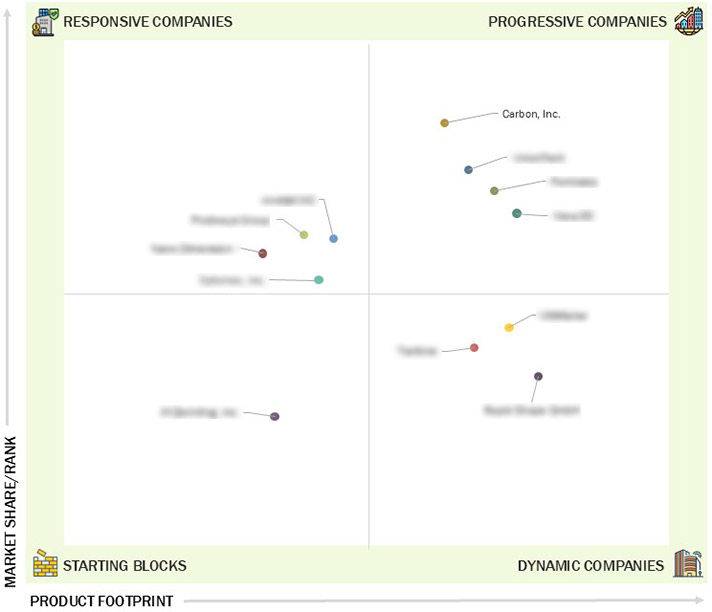Comparing 12 vendors in 3D Printing Startups across 0 criteria.
3D printing, or additive manufacturing, enables the creation of complex objects by layering materials like metals, ceramics, and polymers. It’s increasingly adopted across industries for its ability to produce customized, lightweight, and durable components efficiently. Key technologies such as Selective Laser Sintering and Powder Bed Fusion support diverse applications, from automotive to healthcare. The market is driven by advancements in materials and processes, while challenges include quality consistency and intellectual property concerns. Asia Pacific shows strong growth due to supportive policies and industrial demand.
Market Leadership Quadrant
1.1 Study Objectives
1.2 Market Definition
1.3 Study Scope
1.3.1 Markets Covered
1.3.2 Inclusions and Exclusions
1.3.3 Years Considered
1.3.4 Currency Considered
1.3.5 Unit Considered
1.4 Currency Considered
1.5 Limitations
1.6 Stakeholders
1.7 Summary of Changes
2.1 Introduction
2.2 Market Dynamics
2.2.1 Drivers
2.2.1.1 Ease in manufacturing of customized products
2.2.1.2 Reduction in manufacturing costs and process downtime
2.2.1.3 Increasing government-led investments in 3D printing projects
2.2.1.4 Availability of various industrial-grade 3D printing materials
2.2.1.5 High demand for lightweight yet durable parts in aerospace & defense vertical
2.2.2 Restraints
2.2.2.1 Lack of standardized testing methods to verify mechanical properties of 3D printing materials and high raw material costs
2.2.2.2 Inadequate design and process control data due to lack of printing material specifications
2.2.3 Opportunities
2.2.3.1 Increasing demand for medical products and supplies in post-pandemic scenario
2.2.3.2 Rapid advancements in printing technologies and materials and development of knowledge and skill progression frameworks
2.2.3.3 Emerging applications of 3D printing technology in automotive, printed electronics, jewelry, and education verticals
2.2.3.4 Advancements in 3D printing materials
2.2.4 Challenges
2.2.4.1 Ensuring consistent quality of final 3D-printed products with repeatable and stable production processes
2.2.4.2 Threat of copyright infringement
2.2.4.3 Decline in sales of 3D printing devices attributed to recession
2.3 Trends/Disruptions Impacting Customer Business
2.4 Value Chain Analysis
2.4.1 Research and Development Engineers
2.4.2 Material and Software Providers
2.4.3 Manufacturers
2.4.4 Service Providers
2.4.5 End-User Industries
2.4.6 after-Sales Service Providers
2.5 Ecosystem Analysis
2.5.1 Material Suppliers
2.5.1.1 Polymer providers
2.5.1.1 Metal providers
2.5.2 Software Providers
2.5.3 Printer Providers
2.5.3.1 Industrial 3D printer providers
2.5.3.1 Desktop 3D printer providers
2.5.4 Service Providers
2.6 Investment and Funding Scenario
2.7 Technology Analysis
2.7.1 Key Technologies
2.7.1.1 Hybrid manufacturing
2.7.1.1 MELD process
2.7.2 Complementary Technologies
2.7.2.1 3D bioprinting and tissue engineering
2.7.2.1 IoT integration and connectivity
2.7.3 Adjacent Technologies
2.7.3.1 Computer numerical control (CNC) machining
2.7.3.1 Injection molding
2.8 Patent Analysis
2.8.1 List of Patents
2.9 Key Conferences and Events
2.10 Porter’s Five Forces Analysis
2.10.1 Threat of New Entrants
2.10.2 Threat of Substitutes
2.10.3 Bargaining Power of Suppliers
2.10.4 Bargaining Power of Buyers
2.10.5 Intensity of Competitive Rivalry
2.11 Tariff Impact Analysis
2.12 Key Tariff Rates
2.13 Key Impacts on Various Regions
2.13.1 US
2.13.2 Europe
2.13.3 Asia Pacific
2.14 Impact on Vertical
2.14.1 Automotive
2.14.2 Aerospace & Defense
2.14.3 Healthcare
2.14.4 Architecture & Construction
2.14.5 Consumer Goods
2.14.6 Education
2.14.7 Industrial
2.14.8 Energy
2.14.9 Printed Electronics
2.14.10 Jewelry
2.14.11 Food & Culinary
2.14.12 Other Verticals
2.15 Impact of AI on 3D Printing Market
2.16 Applications: Prototyping, Tooling, and Functional Part Manufacturing
2.17 End-User Industries: Automotive, Aerospace & Defense, Construction, and Culinary
3.1 Introduction
3.2 Strategies Adopted By Key Players
3.3 Revenue Analysis
3.4 Market Share Analysis
3.5 Company Valuation and Financial Metrics
3.6 Brand/Product Comparison
3.7 Company Evaluation Matrix: Startups/SMEs
3.7.1 Progressive Companies
3.7.2 Responsive Companies
3.7.3 Dynamic Companies
3.7.4 Starting Blocks
3.7.5 Competitive Benchmarking: Startups/SMEs
3.7.5.1 Detailed list of key startups/SMEs
3.7.5.2 Competitive benchmarking of key startups/SMEs
3.8 Competitive Scenario
3.8.1 Product Launches
3.8.2 Deals
4.1 Carbon , Inc.
4.1.1 Business overview
4.1.2 Products/Solutions/Services offered
4.1.3 Recent developments
4.2 Formlabs
4.2.1 Business overview
4.2.2 Products/Solutions/Services offered
4.2.3 Recent developments
4.3 UnionTech
4.3.1 Business overview
4.3.2 Products/Solutions/Services offered
4.3.3 Recent developments
4.4 Nexa3D
4.4.1 Business overview
4.4.2 Products/Solutions/Services offered
4.4.3 Recent developments
4.5 voxeljet AG
4.5.1 Business overview
4.5.2 Products/Solutions/Services offered
4.5.3 Recent developments
4.6 Prodways Group
4.6.1 Business overview
4.6.2 Products/Solutions/Services offered
4.6.3 Recent developments
4.7 Nano Dimension
4.7.1 Business overview
4.7.2 Products/Solutions/Services offered
4.7.3 Recent developments
4.8 Optomec , Inc.
4.8.1 Business overview
4.8.2 Products/Solutions/Services offered
4.8.3 Recent developments
4.9 UltiMaker
4.9.1 Business overview
4.9.2 Products/Solutions/Services offered
4.9.3 Recent developments
4.10 Tiertime
4.10.1 Business overview
4.10.2 Products/Solutions/Services offered
4.10.3 Recent developments
4.11 Rapid Shape GmbH
4.11.1 Business overview
4.11.2 Products/Solutions/Services offered
4.11.3 Recent developments
4.12 XYZprinting
4.12.1 Business overview
4.12.2 Products/Solutions/Services offered
4.12.3 Recent developments


 Engineering.com
Engineering.com
 Nov 2025
Nov 2025

